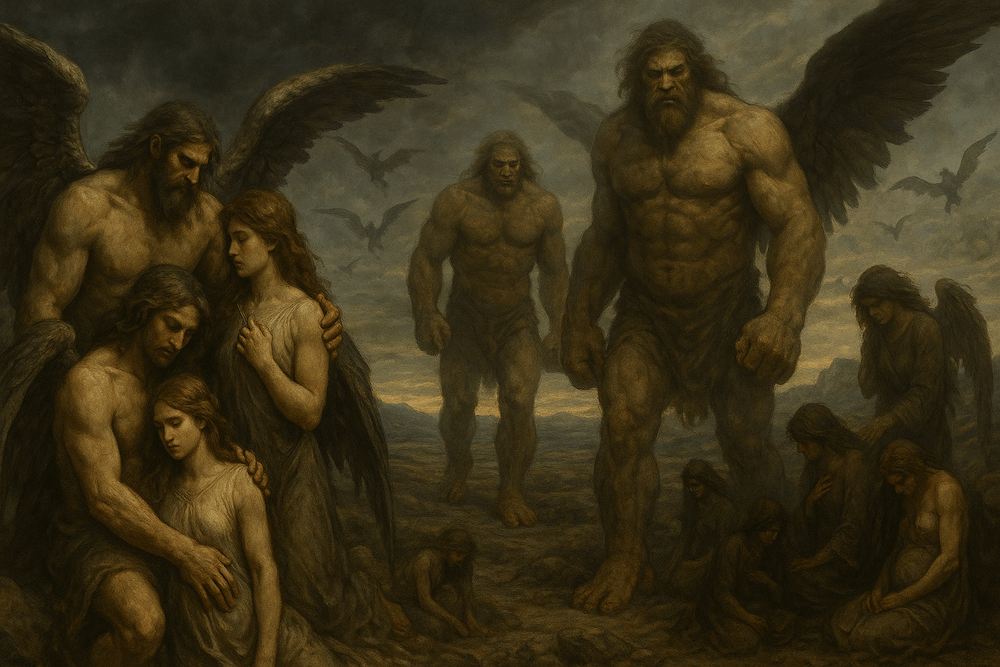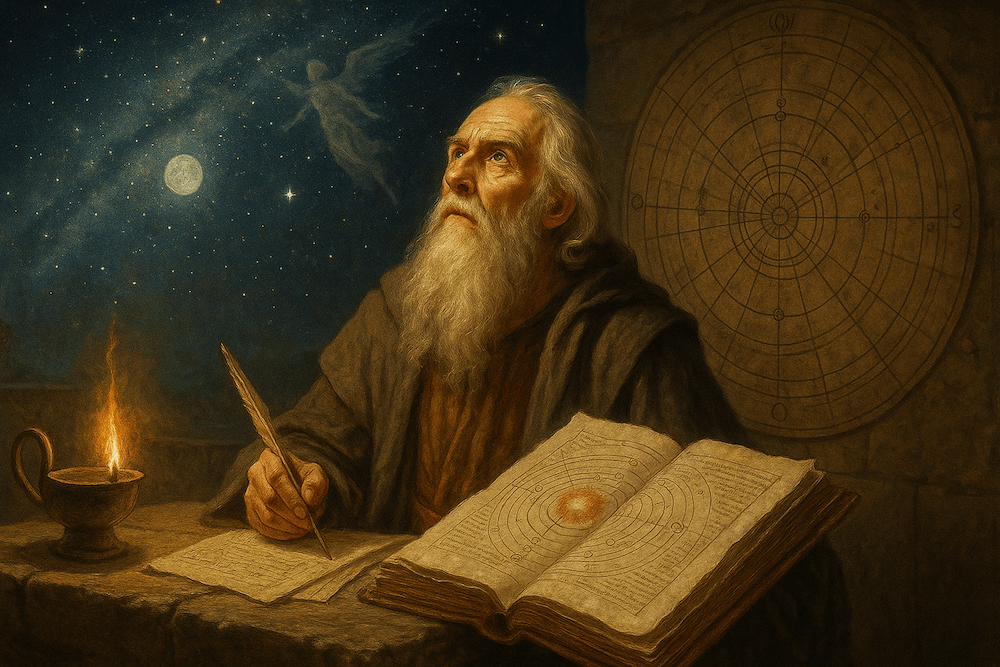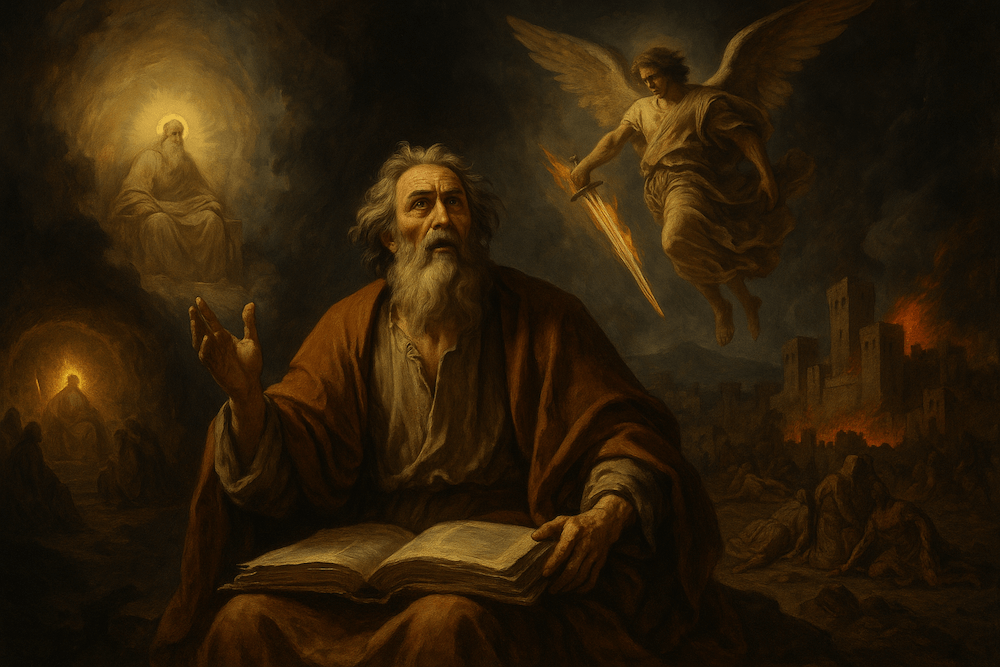The Book of Enoch is one of the most mysterious and important religious texts ever. It connects ancient Judaism with early Christianity, but it is not included in most biblical canons. This old apocalyptic book, which is said to have been written by Enoch, Noah's great-grandfather, gives one of the most detailed accounts of fallen angels and how they interacted with humans in a bad way. But what makes this text so interesting, and why have people been reading it for over two thousand years?

The Strange Person of Enoch
Enoch is an interesting biblical character who is only briefly mentioned in Genesis 5:21–24: "Enoch walked faithfully with God; then God took him away, and he was no more." This mysterious statement implies that Enoch was taken straight to heaven without dying, unlike other people. He lived for 365 years and became the subject of many Jewish and Christian stories that showed him as a visionary, prophet, and scribe of God's judgment.
This enigmatic individual was credited as the author of significant apocalyptic literature that would deeply impact religious thought for centuries. The Book of Enoch depicts him as a mediator between the divine and human realms, receiving visions of cosmic secrets and acting as humanity's advocate before God.
Dating and Historical Context
Contemporary scholarship has determined that the Book of Enoch is a composite text, authored by various writers over several centuries, rather than by the biblical figure Enoch himself. The text is thought to have been written between 300 BCE and 100 CE, with the oldest parts, like the Book of the Watchers, probably being from the 3rd century BCE.
This time frame puts the work right in the middle of the Second Temple period, which was a very difficult time for the Jewish people. Jewish communities were struggling with issues of identity, suffering, and divine justice while living under foreign rule and dealing with cultural and religious challenges from Hellenistic influence. Apocalyptic literature, such as the Book of Enoch, arose in response to these tumultuous periods, providing hope through visions of divine intervention and ultimate justice.
Finding Aramaic fragments in the Dead Sea Scrolls has confirmed that some parts of the book are very old and shown how important it was to Jewish sectarian groups like the Essenes at Qumran.
The Five Books of Enoch
The full Book of Enoch, which has mostly been preserved in an Ethiopic translation, is made up of five parts:

The Book of the Watchers (Chapters 1–36) is the oldest part of the work and tells the main story of fallen angels. It talks about Enoch's visions of heaven and how he prayed for the fallen angels.
The Book of Parables (Chapters 37-71) talks about God's judgment and introduces the mysterious "Son of Man," a title that would later become very important to Christian theology.
The Astronomical Book (Chapters 72–82) tells us about heavenly secrets that Enoch learned from the angel Uriel, such as a solar calendar and detailed descriptions of how the heavens move.
The Book of Dream Visions (Chapters 83-90) gives us symbolic visions of world history from Adam to the Messianic age, using animals to show historical people.
The Epistle of Enoch (Chapters 91-107) has moral lessons and the "Apocalypse of Weeks," which breaks history up into ten cosmic periods.
The Watchers: Sons of Heaven Who Rebelled
The Book of Enoch's most interesting and important part is its detailed description of the Watchers, a group of 200 angels who were sent to watch over and guide people. The text says that these divine beings came down to Mount Hermon during the time of Jared and did something that would change the course of human history forever.
The Watchers, led by angels named Shemihazah (also called Semjaza) and Azazel, made a bad choice: they left their heavenly duties and married human women. This act of rebellion went against the divine order and made the line between the heavenly and earthly worlds less clear.
The text gives the names of the leader angels, such as Samlazaz, Araklba, Rameel, Kokablel, and others. Each of these angels leads a group of ten angels. These fallen beings not only ruined themselves by having illegal relationships with human women, but they also gave people knowledge that was not allowed.
The Forbidden Knowledge
One of the most interesting things about the fallen angels' sin was that they taught people forbidden arts and sciences. In 1 Enoch 8, Azazel "taught men to make swords, knives, shields, breastplates, and bracelets, and made known to them the metals of the earth and the art of working them, and the use of antimony, and the beautifying of the eyelids, and all kinds of costly stones, and all coloring tinctures."
Other Watchers gave people their own kinds of forbidden knowledge:
- Semjaza taught magic and herbalism
- Armaros taught how to break enchantments
- Baraqijal taught astrology
- Kokabel taught about constellations
- Ezeqeel told people about the secrets of clouds and weather
- Araqiel told people about the signs of the earth
- Shamsiel told people about the signs of the sun
- Sariel told people about the course of the moon
People thought that this knowledge was too early and dangerous, even though it helped people make progress in metallurgy, astronomy, cosmetics, and magic. The text says that people were "yet young" and not ready to learn such deep secrets about heaven and earth.
The Nephilim: Kids from Two Worlds
The Nephilim were the children of Watchers and human women. They were giants who were not fully human or fully angelic. People said these beings were violent and destructive, and they caused a lot of trouble and pain on earth. They grew to huge sizes and had superhuman strength. They used up a lot of resources and eventually turned to cannibalism and violence against people.
The Nephilim are a terrible example of what can happen when you cross divine lines. Their existence went against the natural order and helped bring about the corruption that led to the great flood described in Genesis.
Divine Judgment and Cosmic Justice
The Book of Enoch gives a lot of information about how God reacted to the Watchers' rebellion. The archangels Michael, Uriel, Raphael, and Gabriel told God what was going on, and God passed judgment on the fallen angels and their children.
The punishment was harsh: the Watchers would be tied up and put in jail until the final judgment, and their children, the Nephilim, would be killed in war and then by the flood. The text talks about how the giants would fight each other in a destructive way before facing punishment from God.
God chose Enoch to bring this message of judgment to the fallen angels. He was God's messenger and humanity's advocate. The Watchers asked for mercy through Enoch's intercession, but they were not forgiven and their punishment was confirmed.

Impact on Early Christianity
The Book of Enoch had a huge effect on how early Christians thought. The Epistle of Jude clearly quotes from the book, treating it like prophetic scripture: "Enoch, the seventh from Adam, prophesied about them: 'See, the Lord is coming with thousands upon thousands of his holy ones'" (Jude 1:14-15).
Early Christian fathers such as Tertullian, Origen, Irenaeus, Justin Martyr, and Clement of Alexandria esteemed the Book of Enoch, with Tertullian designating Enoch as "the oldest prophet." The apocalyptic themes, angelology, and ideas of divine judgment in the text had a big impact on early Christian theology.
The book's use of the term "Son of Man" to refer to a messianic figure came before and may have influenced how the New Testament used the term to refer to Jesus. The comprehensive depictions of heaven, hell, and the final judgment exhibit similarities to Christian apocalyptic literature, notably the Book of Revelation.
Theological Contributions and Enduring Legacy
The Book of Enoch made many important contributions to theology that still matter today:
Origin of Evil
In contrast to the Genesis narrative, which blames Adam and Eve's disobedience for humanity's fall, Enoch assigns the principal responsibility for the emergence of evil to the fallen angels. This different way of looking at suffering and corruption changed the way people thought about theodicy, which is the question of why evil exists in a world made by a good God.
Angelology
The text gives a lot of information about angelic hierarchies, names, and roles, which greatly expands biblical angelology. This had an impact on later Jewish mysticism, Christian demonology, and how people thought about angels and demons.
Apocalyptic Worldview
Enoch's cosmic view, which focused on God's judgment, the resurrection of the dead, and ultimate justice, had a big impact on apocalyptic thought in both Judaism and Christianity.
Intermediate State
The book talks about what happens to souls after they die, saying that the good go to one place and the bad go to another. These ideas had an impact on later Christian ideas about heaven, hell, and purgatory.
Why Was It Not Included in the Canon?
The Book of Enoch was popular at first, but over time it was left out of Christian biblical canons. There were a number of things that led to this decision:
Doctrinal Concerns: The text's in-depth study of angels and the universe sometimes conflicted with the growth of orthodox Christian doctrine. It focused on fallen angels as the main source of evil, which went against other religious explanations.
Questions of Authorship: As textual criticism grew, church leaders began to doubt that the historical Enoch could have written such detailed prophetic works.
Canonical Stability: By the 4th century CE, church councils were trying to set up stable biblical canons. They often chose texts that had stronger links to the apostles and clearer doctrinal consistency.
Cultural Changes: As Christianity spread beyond Jewish communities, texts that were very important to Jewish apocalyptic tradition became less important to Christian identity.
Rediscovery in the Present and Ongoing Impact
For more than a thousand years, the Book of Enoch was lost to Western Christianity. It survived mostly in Ethiopian Orthodox Christianity, where it is still considered canonical. Scottish explorer James Bruce brought the first full Ethiopic manuscripts to Europe in 1773. This sparked renewed interest among scholars and the general public.
Finding Aramaic pieces among the Dead Sea Scrolls in the 20th century proved that the text was old and Jewish, which made it even more important for understanding Second Temple Judaism and early Christianity.
The Book of Enoch is still interesting to scholars, theologians, and people who are interested in ancient wisdom traditions. You can find its themes in:
- Academic studies of apocalyptic literature
- Comparative religion and mythology
- Popular fiction and conspiracy theories
- New Age and esoteric spirituality
- Research in archaeology and texts
Conclusion: A Link Between Two Worlds
The Book of Enoch is an amazing link between the old and new worlds, the Jewish and Christian traditions, and the human and divine realms. Its story of fallen angels and forbidden knowledge deals with questions that have been around for a long time, like what evil is, how much we can know, and the hope for divine justice.
The Book of Enoch, whether seen as old myths, religious texts, or spiritual wisdom, still makes people think about cosmic views of human life. The idea of Watchers who chose earthly desires over heavenly duties is a strong metaphor for what happens when you break divine rules.
In our modern world, where technology is advancing quickly and raising questions about forbidden knowledge and its effects, Enoch's old warnings about getting wisdom too soon and cosmic responsibility are still surprisingly relevant. The text reminds us that some knowledge comes with a lot of responsibility and that we should think about morality when we want to learn more.
The Book of Enoch is still popular because it tells dramatic stories about fallen angels and giants. But it is also popular because it says that the universe is governed by moral laws, that injustice will be punished, and that human history is part of a larger cosmic drama in which divine justice will win out.
